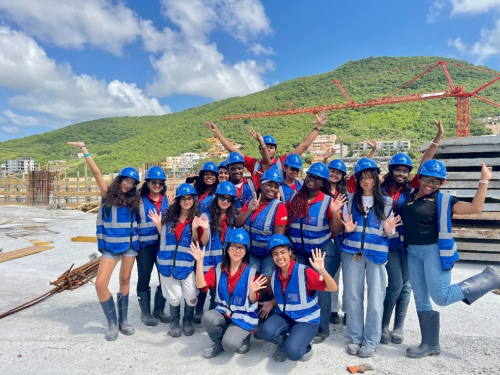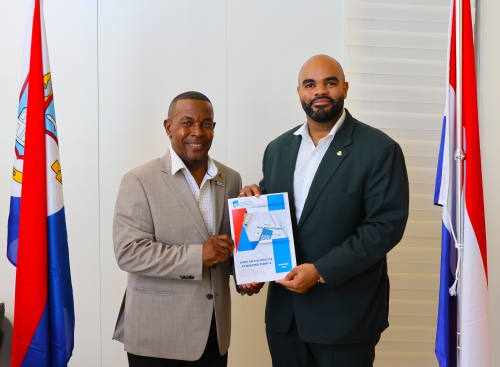 CAY HILL:--- Sixteen writers of Teen Times, a newspaper supplement of The Daily Herald for teenagers, recently toured the construction site of the new St. Maarten General Hospital (SMGH). Upon arrival, the excited writers were provided with personal protective equipment (PPE) to ensure their safety during the tour, as it is an active construction site.
CAY HILL:--- Sixteen writers of Teen Times, a newspaper supplement of The Daily Herald for teenagers, recently toured the construction site of the new St. Maarten General Hospital (SMGH). Upon arrival, the excited writers were provided with personal protective equipment (PPE) to ensure their safety during the tour, as it is an active construction site.
The tour began with a presentation on SMMC and SMGH to allow the writers to make a connection between the construction concepts, technical drawings, floor plans, and the current progress. The presentation, given by SMGH Project Manager Erika van der Horst and Senior Communications Officer Shari de Riggs, covered various topics related to the hospital and the construction project, such as SMMC’s history and current operations, construction progress, upcoming construction activities, and career opportunities within the new hospital.
Many of the writers attended SMMC’s Community Clean-up of Little Bay Pond and bird watching tour earlier in November and were able to make a link between the interior concept of the building and real-life inspiration. After the presentation and safety briefing by the Health and Safety Officer of FINSO, the project’s general contractor, the team was led to the highest current point of the building, which was the fifth floor/technical level and worked their way back down to the ground floor. They were also able to see the future Operating Theaters, Dialysis Department, Radiology Department and Emergency Room. An eye-opener for them was seeing the less than one meter space between the new building and the current facility.
The writers posed many thoughtful questions, indicating their interest in the future of the island’s healthcare and hospital care systems and were invited to return for another tour upon the completion of the project.
“We were delighted to welcome the bright, young minds of the Teen Times team for a behind-the-scenes look at our hospital construction project. Engaging with the next generation of future healthcare professionals, community members, and patients of SMGH is essential as we work to build a sustainable, high-quality healthcare system that will serve them and generations to come, right here close to home”, remarked SMMC.
Both construction and organizational transition activities are in full swing as the hospital prepares to move from SMMC to SMGH in the near future.
Extended Deadline Announced for Window 1 – Regional MSME Matching Grants Programme.
The Organisation of Eastern Caribbean States (OECS) Commission, through the Unleashing the Blue Economy of the Caribbean (UBEC) Project, is pleased to announce an extension to the Second Call for Proposals under Window 1 of the Regional MSME Matching Grants Programme.
Originally scheduled to close on Friday, November 21, 2025, the application deadline has now been extended to Friday, December 5, 2025 at 11:59 PM.
This extension offers welcome news and a second chance for Micro, Small, and Medium Enterprises (MSMEs) that may have missed the original deadline. Eligible MSMEs operating in the Fisheries (including aquaculture), Marine Tourism, and Waste Management sectors in Grenada, Saint Lucia, and Saint Vincent & the Grenadines now have additional time to submit their applications and take advantage of this transformative opportunity.
A Powerful Opportunity for Blue Economy Growth
The Regional MSME Matching Grants Programme provides funding support ranging from USD $5,000 to $25,000 to help enterprises:
Upgrade equipment and facilities
Improve production and processes
Strengthen sustainability and resilience
Expand market reach and competitiveness
Build capacity through training and technical support
Already, MSMEs awarded during the First Call for Proposals are experiencing significant improvements in operations, livelihoods, and business growth, demonstrating the programme’s real impact on the Blue Economy across the region.
Training Support Already Underway
As part of the programme’s commitment to building stronger businesses:
Training sessions are currently underway in Grenada and Saint Vincent & the Grenadines, equipping MSMEs with skills in business development, financial literacy, marketing, and sustainability.
Saint Lucia has successfully completed its training series, with participants reporting increased confidence, readiness, and practical knowledge to strengthen their enterprises and prepare competitive grant applications.
A Final Call to Apply
MSMEs are strongly encouraged to take this final opportunity to submit their proposals, strengthen their businesses, and access funding that can transform their future within the Blue Economy.
How to Apply
A short instructional video on how to apply and submit proposals is included with this release to support applicants through the process.
SER Curaçao issues advice on proposed tariff structure for medical laboratory diagnostics.
WILLEMSTAD:--- Curaçao’s Social and Economic Council (Sociaal-Economische Raad, SER) today issued an advisory opinion to the Minister of Health, Environment and Nature (GMN), Mr. Gilmar Pisas, concerning a draft national decree that would amend the Landsbesluit Verstrekkingen Basisverzekering Ziektekosten 2014 and the Landsbesluit Medisch Tarief Sociale Verzekeringen 2001. The measure seeks to update the national schedule for medical laboratory diagnostics and establish maximum tariffs for each procedure that laboratories may charge the Social Insurance Bank (Sociale Verzekeringsbank, SVB).
The scheduled tariff framework has, over time, become disconnected from the operational and technological realities of laboratory diagnostics. It is increasingly outdated, incomplete, and internally inconsistent, and no longer reflects present-day diagnostic practice. Rapid advances in technology and the growing complexity of laboratory services have widened the divide between the regulated tariffs and routine clinical operations. The proposed decree aims to bring the tariff structure into alignment with medical, technological, and societal developments, while contributing to efforts to contain health-care costs.
In its review, the SER of Curaçao also examined the approach of comparable jurisdictions to health-care tariff regulation. In the Netherlands, the Trade and Industry Appeals Tribunal (College van Beroep voor het bedrijfsleven, CBb) has made clear in several judgments that regulators must provide a transparent basis for how tariffs are set, disclose the cost-structures underpinning those decisions, and take measures to ensure that tariff regulation does not impose a disproportionate burden on providers. The tribunal’s jurisprudence underscores principles of careful preparatory work, transparent reasoning, and the protection of property rights under Article 1 of the First Protocol to the European Convention on Human Rights (ECHR).
The SER’s advisory opinion addresses the legal, economic, and operational facets of the proposed tariff framework and considers the potential implications for laboratories, payers, and patients once the decree is finalized.
Wescot-Williams Calls for Homegrown Alternative to Black Friday with 'Strength Savings.
 PHILIPSBURG:--- President of Parliament Sarah A. Wescot-Williams is encouraging St. Maarten’s business community to embrace a locally rooted alternative to Black Friday by adopting 'Strength Savings’ during the island’s Thanksgiving period, particularly on Friday, December 5th, and Saturday, December 6th.
PHILIPSBURG:--- President of Parliament Sarah A. Wescot-Williams is encouraging St. Maarten’s business community to embrace a locally rooted alternative to Black Friday by adopting 'Strength Savings’ during the island’s Thanksgiving period, particularly on Friday, December 5th, and Saturday, December 6th.
Wescot-Williams acknowledged that many businesses have already announced Black Friday promotions. Rather than discarding those efforts, she urged retailers to shift or extend their major sales into the first weekend of December under the 'Strength Savings’ banner. “Black Friday is not part of our history or cultural identity,” she said. “But St. Maarten’s Thanksgiving is, and it is built on our resilience as a people. 'Strength Savings' gives us a way to celebrate that spirit while supporting our local economy.”
She reaffirmed that St. Maarten’s Thanksgiving, observed on the first Sunday of December, is a tradition born out of faith, gratitude, and the strength shown after every storm. “At a time when we commemorate our resilience and offer thanks as an island, it is fitting that our business community joins in this moment, not by following imported customs, but by uplifting our own.”
Wescot-Williams encouraged retailers of all sizes to consider adopting 'Strength Savings', Built on Resilience. Celebrated with Savings, as an island-wide initiative, reinforcing national identity while offering meaningful value to residents and visitors.
“Let us take pride in what is ours. This December, I encourage our businesses to lead with the same strength that defines our people.”
Audit Chamber Presents Report on Permit Process to Minister Of VROMI.
~Gumbs outlines ongoing and future Improvement Measures~
 PHILIPSBURG:--- The General Audit Chamber officially handed over its audit report on the building permit issuance and denial process to the Minister of Public Housing, Spatial Planning, Environment, and Infrastructure (VROMI) Patrice Gumbs during a productive meeting focused on transparency, efficiency, and reform.
PHILIPSBURG:--- The General Audit Chamber officially handed over its audit report on the building permit issuance and denial process to the Minister of Public Housing, Spatial Planning, Environment, and Infrastructure (VROMI) Patrice Gumbs during a productive meeting focused on transparency, efficiency, and reform.
The audit examined the legal framework, procedural integrity, and data usage in St. Maarten's building permit process (2020-2024), a critical system for managing development on an island with limited land resources, fragile ecosystems, and infrastructure constraints. The report is intended as a roadmap to reduce fraud risks and improve efficiency in permitting processes.
The audit revealed that St. Maarten's permitting framework is fragmented and outdated. The Building and Housing Ordinance of 1935 remains the primary legal basis for construction, supplemented by ordinances and non-binding policies that lack formal legal status. The long-awaited island-wide zoning plan remains incomplete, forcing staff to interpret outdated policies on a case-by-case basis, which increases risks of inconsistent enforcement and legal uncertainty.
The permit process operates largely through manual, paper-based workflows. While applications are logged in the system, neither applicants nor management can track progress effectively. Critical safety advice from entities like the Fire Department is sometimes disregarded without written justification, and ministerial decisions can deviate from expert recommendations without documented reasoning.
Significant capacity constraints were identified. The Permits Department operates with limited staff, many lacking technical qualifications specified in official function descriptions, and no structured training program exists. At the time of the audit, only one Fire Department officer handled all permit-related reviews.
During the handover meeting, the Ministry welcomed the five key recommendations and outlined concrete steps to address the recommendations:
Standard Operating Procedures (SOPs): The Ministry echoed the urgent need for SOPs to curb discretionary and inconsistent permit decisions. The Civil Works manual has been finalized, and will soon be published, clarifying circumstances under which certain permits are required. The creation of a general workflow document will also commence, to ensure uniform evaluation, through clear procedures, which will also help to mitigate the potential for a backlog.
Digitalization: Recognizing that paper-based processes increase inefficiency and risk, the Ministry is preparing a Terms of Reference for automating and digitizing permitting processes. The request for managing this procurement, on behalf of the Ministry, is set for review at the end of next week. The digitalization effort will focus on improved customer communication, status tracking, and transparency.
Capacity Building: The Netherlands, through the Ministry of BZK, provided VROMI €1.4 million to build capacity for the trust-fund related projects. Subsequent discussions have given way for the subsidy to also be used for building the necessary secondary capacity within the Ministry. The Ministry will be hiring between 6 and 9 people for a period of one year. VROMI is collaborating with the Ministry of VSA’s National Employment Services Center (NESC) and will use their database to fill the vacancies, where possible. The vacancies are live as of today and can be found on the Government’s social media. Interested people are encouraged to apply; the deadline is set for Friday, December 5, 2025. More structurally, the Ministry is in discussion on revising the existing function book, which regulates the positions, salaries, and tasks of civil servants.
Accountability and Documentation: The Audit Chamber voiced its concerns regarding Ministerial deviation, that is, the ability of Ministers to accept or deny building permits without proper substantiation. The Minister outlined his efforts to ensure transparent decision-making with the introduction of memos that document concerns and deviations, if applicable. The Audit Chamber welcomed this initiative but noted that political change could mean the return to unsubstantiated deviations as observed in the past, underscoring the need to make mandatory, through law, the substantiation of a Ministerial deviation.
Policy Updates: The Ministry outlined progress on several policies, including the land policy, the spatial economic strategy, the land price policy, and the domain affairs backlog, which have all been recently approved by the Tijdelijke Werkorganisatie (TWO). In addition, the Ministry is awaiting the approval of its proposal to TWO for the completion of the zoning process for Sint Maarten. The Minister viewed the lack of uniformity in zoning as an obstacle to development.
“The lack of zoning creates an unclear and subsequently unfair playing field for persons who wish to develop a parcel of land. Approval currently relies on ministerial discretion to accept or deny the proposed advice. The realization of this zoning, coupled with our timeline to have a corrected National Decree on Administrative Enforcement by Q2 2026, will support our policies on beach and hillside use and strengthen our ability to implement and enforce our own laws”, stated Gumbs.
The General Audit Chamber thanked the Ministry for its exceptional cooperation, recognizing the openness of the staff throughout the audit process. The Minister invited the Audit Chamber to consider a follow-up report to assess the impact of the ongoing and proposed initiatives. Both parties commended the spirit of cooperation and emphasized the shared goal of depoliticizing and professionalizing the Ministry's operations through transparency and sustainable procedure reforms.
The complete report is available on the General Audit Chamber's website.